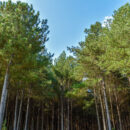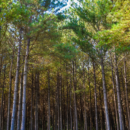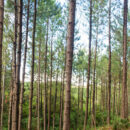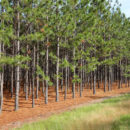FNC News
Establishing a Pine Plantation Phase 2: Planting
In earlier articles, we discussed the decisions a landowner must make after completing a total harvest operation on their property, followed by an overview of common site prep methods. The next step is the planting process.
As stated previously, this series of articles will focus on the process of establishing a pine plantation to generate income.
There are three species of pine that can be found in the East Texas area: loblolly pine, shortleaf pine, or longleaf pine. Loblolly pine is the seedling of choice when planting a pine plantation to generate income. For over 60 years, researchers have been genetically improving loblolly pine seedlings and landowners can take advantage of these genetic improvements based on the class of seedlings they choose.
Landowners must decide whether they want to plant bare root or containerized seedlings. Bare root seedlings are just that… bare root. After one year of growth at the nursery, bare root seedlings are lifted (pulled from the ground), sorted and bagged, then placed in cold storage. There was a time, not too many years ago, that bare root was the only option for seedlings. However, nurseries are now cultivating containerized seedlings. Containerized seedlings are grown in a container and have a plug of soil around their roots. These containers are lifted and boxed, then placed in cold storage. Containerized seedlings normally have a higher survival rate than bare root seedlings, but are also more costly. Landowners must weigh the pros and cons of each seedling when deciding which to plant.
Once the landowner has chosen their seedlings, they have the option of either hand planting or machine planting. Wildland machine planting uses a small bulldozer to pull a heavy planting machine behind it. As the planter machine is pulled along, a coulter blade, or wheel, cuts through the soil and opens a narrow slit in the ground. The planting foot is behind the coulter and widens the furrow. The seedlings are placed in a mechanical arm inside the planting machine. This arm rotates as it is pulled and plants the trees in the furrow at a predetermined spacing. As the trees are planted, planting wheels (slightly tilted wheels behind the planter) pack the soil around the seedlings, closing the furrow.
Hand planting utilizes planters who walk over the property planting trees with a tool such as a dibble bar, HoeDad, or planting shovel. The planter carries a bag of seedlings strapped to their hips and plants the seedlings on a spacing predetermined by the landowner or the landowner’s agent. Tracts where little or no site prep has been done or tracts that are rough, small, or inaccessible to machine planters benefit from hand planting. This method is generally less expensive than machine planting, but on average has poorer survival.
The Forestry Division of Farmers National Company can help you make an informed decision, based on our years of experience, as to which seedlings and planting method will help achieve your goal and maximize income from your investment.
More News




